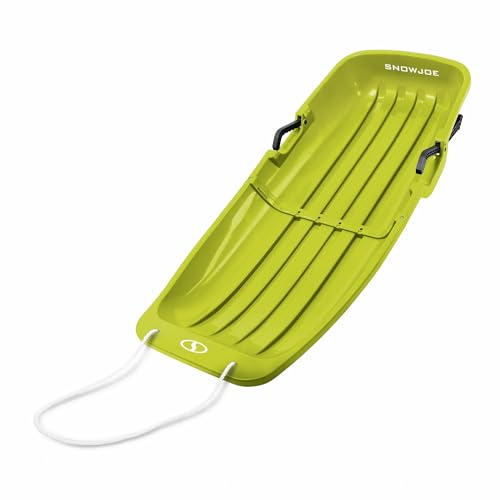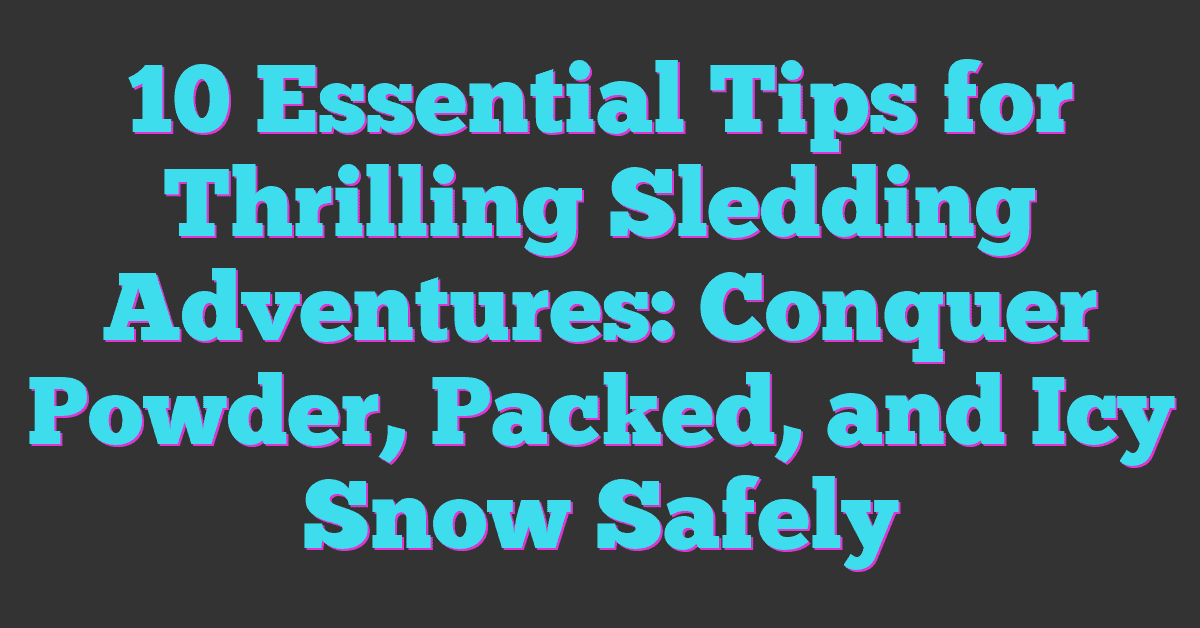Are you ready for some exhilarating winter fun? Look no further than the thrilling activity of sledding! But wait, before you grab your sled and head out, have you ever wondered what makes the best snow for sledding? In this article, we’re going to explore the key factors that contribute to the perfect sledding conditions. From the type of snow to the ideal weather conditions, we’ve got you covered with all the tips and tricks to ensure you have an unforgettable sledding experience.

Picture this: you’re gliding down a snowy hill, the wind in your hair, and a smile on your face. That’s the magic of sledding! But what exactly makes the snow ideal for this thrilling winter activity? Well, it turns out that the best snow for sledding is not just any ordinary snow. In fact, there are a few important characteristics that can make or break your sledding adventure. So, whether you’re a seasoned sledding enthusiast or a first-timer, understanding these factors will help you make the most of your snowy escapades.
When it comes to sledding, the type of snow you encounter can greatly impact your experience. You might think that fresh, powdery snow is the best choice, but that’s not always the case. Surprisingly, the best snow for sledding is often the slightly packed or compacted snow. This type of snow provides a smooth and fast ride, allowing you to glide effortlessly down the slope. So, next time you head out for a sledding adventure, keep an eye out for that perfect blend of packed snow that will make your ride an absolute thrill.
The Importance of Snow Quality for Sledding
When it comes to sledding, the quality of the snow can make all the difference in your experience. As an avid snow sports enthusiast, you know that the right type of snow can turn a mediocre sled ride into an exhilarating adventure. So, let’s explore why snow quality is crucial for sledding and how it can enhance your winter fun.
1. Speed and Smoothness
The primary factor that affects your sledding experience is the speed and smoothness of the ride. Packed or compacted snow is ideal for sledding because it offers less resistance. It allows you to glide effortlessly down the hill, increasing your speed and the thrill factor. The compacted snow creates a hard surface that reduces friction, providing a smooth ride that sends you zooming down the slope.
2. Maneuverability
Snow quality also impacts your ability to control and maneuver your sled. Fresh, powdery snow may be great for making snow angels, but it’s not ideal for sledding. The fluffy texture of powdery snow creates resistance, making it harder to steer your sled and navigate around obstacles. On the other hand, packed snow offers better traction and stability, allowing you to make quick turns and maneuvers with ease.
3. Safety
Safety is always a top priority when engaging in winter activities. Proper snow quality plays a significant role in ensuring a safe sledding experience. Packed snow provides a solid base that reduces the risk of your sled digging into the ground or hitting hidden obstacles. It also minimizes the chance of accidents, such as losing control or tipping over while sledding.
4. Durability and Longevity
The durability and longevity of the snow are also important factors to consider for an enjoyable sledding adventure. Packed snow tends to last longer compared to fresh snowfall, which can melt or get compacted over time. This means you can enjoy sledding for more extended periods, even after multiple runs or if the weather starts to warm up.
What Makes for Great Sledding Snow?
As an avid snow sports enthusiast, you know that finding the perfect snow conditions can make or break your experience. When it comes to sledding, the type of snow you encounter can greatly impact your ride. So, what makes for great sledding snow?
1. Packed and Compacted Snow:
The best snow for sledding is packed or compacted snow. This type of snow has been compressed and flattened, resulting in a smooth and fast surface. It allows your sled to glide effortlessly down the slope, giving you that exhilarating rush of speed. The compacted snow also offers better maneuverability and control, allowing you to steer and navigate your sled with ease.
2. Moderate Moisture Content:
While powdery snow might look picturesque, it’s not the most ideal for sledding. Too much moisture in the snow can make it heavy and slow you down, while too little moisture can make it icy and slippery. The best sledding snow has a moderate moisture content, striking the perfect balance between speed and control.
3. Durability and Longevity:
Great sledding snow is not only about the initial ride, but also about longevity. Packed snow is more durable and long-lasting, which means you can enjoy endless hours of sledding fun without having to constantly search for new slopes or worry about the snow wearing down quickly. It’s important to choose a hill with well-compacted snow that will hold up under repeated use.
4. Safe Conditions:
Before venturing out, always check the snow conditions and ensure it’s safe for sledding. Look for hills that have been groomed and maintained, as they are more likely to have well-packed snow. Avoid sledding on hills with obstacles or icy patches, as this can increase the risk of accidents.
Understanding Different Types of Snow
When it comes to sledding, not all snow is created equal. As an avid snow sports enthusiast, you know that the quality and texture of the snow can greatly impact your sledding experience. Let’s take a closer look at the different types of snow and how they can affect your ride down the slope.
Fresh Powdery Snow
Fresh powdery snow is what many people dream of when they imagine a winter wonderland. While it may be perfect for skiing or snowboarding, it might not be the best for sledding. The fluffy nature of powdery snow can slow down your sled and make it more difficult to glide smoothly. It can also be challenging to control your sled, especially on steeper slopes.
Packed or Compacted Snow
On the other hand, packed or compacted snow is a sledder’s dream. This type of snow has been compressed by other sleds or foot traffic, creating a smooth and fast surface. Packed snow allows your sled to glide effortlessly, giving you a thrilling ride down the hill. It also provides better maneuverability and control, reducing the risk of accidents. Plus, packed snow is more durable and long-lasting, allowing for extended periods of sledding enjoyment.
Moisture Content
The moisture content of the snow is also important when it comes to sledding. Too much moisture can make the snow heavy and sticky, slowing down your sled and making it harder to maneuver. On the other hand, if there’s not enough moisture, the snow may be too dry and loose, also affecting your sledding experience.
Best Snow Conditions for Sledding
You’re an avid snow sports enthusiast, and nothing gets you more excited than a fresh blanket of snow. Winter is your favorite time of year, and you eagerly anticipate the opportunity to hit the slopes and indulge in some sledding fun. However, not all snow is created equal when it comes to sledding.
When it comes to sledding, the best snow conditions can make all the difference in your experience. The perfect snow for sledding is packed or compacted snow. This type of snow provides a smooth and fast ride, allowing you to glide effortlessly down the hill. The packed snow offers better maneuverability and control, reducing the risk of accidents and spills.
Why is packed snow ideal for sledding? Well, it’s simple really. Packed snow is more durable and long-lasting compared to fresh, powdery snow. It can withstand the weight and pressure of repeated sled runs, allowing for extended periods of sledding enjoyment. So, the more packed the snow is, the longer the fun lasts.
Moisture content also plays a role in the quality of snow for sledding. Ideal snow conditions for sledding contain just the right amount of moisture. If the snow has too much moisture, it can slow you down and make the ride less exciting. Conversely, if the snow is too dry and lacks moisture, it may be harder to control your sled and maintain your speed.
Before you embark on your sledding adventure, always check the snow conditions. Look for hills with packed or compacted snow and avoid hills with obstacles or icy patches that could increase the risk of accidents. Don’t forget to gear up with appropriate winter clothing and protective gear for a safe and enjoyable sledding experience.
Tips for Finding the Best Snow for Sledding
As an avid snow sports enthusiast, you know that finding the right snow can make all the difference when it comes to enjoying your time on the slopes. And sledding is no exception! Here are some tips to help you find the best snow for an exhilarating sledding experience.
- Look for packed or compacted snow: When it comes to sledding, packed snow is your best friend. It provides a smooth and fast ride, allowing you to glide effortlessly down the hill. The tightly packed snow also offers better maneuverability and control, reducing the risk of accidents. So keep an eye out for slopes with well-traveled paths or areas where the snow has been compacted through natural means.
- Consider the moisture content: The moisture content of the snow plays a significant role in your sledding experience. Too much moisture can slow you down, making the ride sluggish. On the other hand, if the snow is too dry, it can reduce your control, making it harder to steer. Look for snow that is moist enough to provide a good balance between speed and control.
- Check the snow conditions: Before you head out for a day of sledding, take a moment to check the snow conditions. Avoid hills with obstacles or icy patches, as these can pose safety hazards. It’s essential to ensure that the snow is safe and suitable for sledding to make the most of your adventure.
- Dress appropriately: Sledding may seem like a fun and carefree activity, but it’s essential to dress appropriately for the weather. Layer up with warm and waterproof clothing to stay dry and comfortable. Don’t forget to wear a helmet for added safety.
Conclusion
Now that you know what type of snow is best for sledding, you can make the most out of your winter adventures. Packed snow is the key to a smooth and fast ride, offering better control and maneuverability. It’s also more durable, so you can enjoy sledding for longer periods of time. Remember to check the snow conditions before you start, ensuring that it’s safe and free from obstacles or icy patches. And don’t forget to gear up with the appropriate winter clothing and protective gear for a safe and enjoyable sledding experience. So grab your sled, find a hill with the right kind of snow, and get ready for an exhilarating ride down the slopes!













